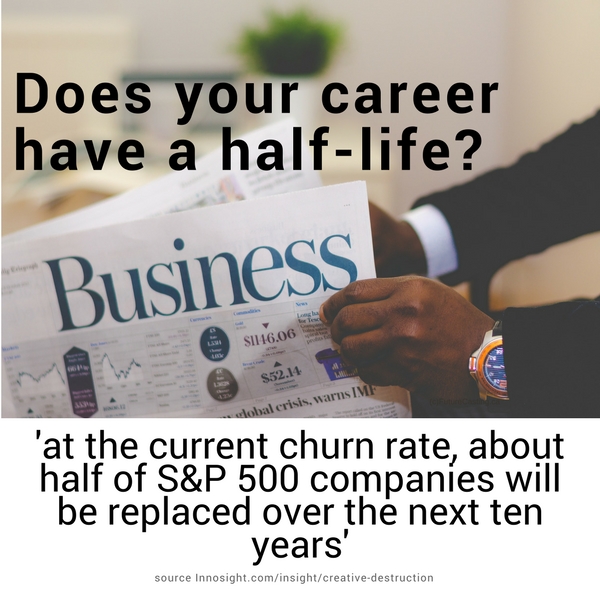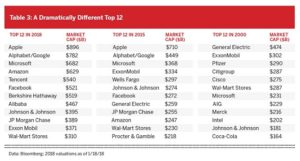
21 Feb 3 career lessons you can learn from analyzing corporate longevity
Short read: If Corporations are constantly evolving to expand their longevity and stay relevant, maybe you should too.
- Companies that want to stay relevant longer are constantly retooling, restructuring and re-evaluating possible threats. Change is the new normal.
- Half the companies on the S&P 500 companies will be replaced on that index over the next 10 years. That churn is interesting and indicative of the effects of disruption and M&A.
- Company longevity has decreased from 33 years in 1964 to a forecasted 12 years in 2027. It is an accelerating downward trend.

Let’s do the math
If a corporation has to constantly be watching and morphing so it can outlast a constantly shrinking corporate lifespan:
- GenZ young adult are making higher education and career decisions today in Grade 10/Sophomore that will land them their first job at earliest 6 years from now. As a steward of this generation, how can this information help up help them?
- What are you doing to ensure you are personally innovating and re-tooling to stay relevant within your organization, and to ensure your organization stays relevant longer?
Does your career have a half-life?
The Longer Read: Career Half-life lessons we can learn from analyzing Corporate Longevity on the S&P 500
It started with someone posting a link to Innosight’s 2018 Corporate Longevity Briefing. An interesting read, especially if you follow the stock market.
Giants can be replaced
But from a strategic planning perspective, one graphic bounced out:

Solid stalwart performers like Dell Computers and Yahoo! which had been part of the index for over 17 years were replaced by Facebook and Under Armour. 50-year veteran DuPont and 35-year Ryder which runs transportation across North America dropped off to be replaced by larger players FinTech PayPal and alternate energy Alliant Energy. Many companies – even dominant players like Yahoo! have been taken over sometimes by competitors – and sometimes had to adjust their corporate and management culture to survive within the new organization.
A look at the next table, shows how different sectors have come to dominate the market – and how rapidly that swing is happening. Retail giants like Wal Mart are now relegated by Alibaba. So, where will the next opportunity lie?

What can we learn from this as individuals?
- Reset our expectations. Change is already the new constant. No one can afford to be complacent. Stewards working with young adults need to talk about enjoying the journey vs aiming for one destination – because the destination is constantly shifting. If a corporation is not reinventing itself, watching for possible opportunities or leveraging partnerships, it runs the risk of being overshadowed, taken over or replaced.
- We have to learn to implement streamlined corporate survival strategies within our personal lives so we have the same advantages – M&A & Marketing = Partnerships & Networks – keep the new work pipeline loaded; Strategic Planning & Threat Assessment = Scenario Planning & FutureCasting; Budget vs Actual = Personal Fiscal responsibility.
- Doors are either going to shut or open to new opportunities – always look for the opportunities. The corporations that do not see the challenge or competition coming will get eaten (anyone remember Eastman Kodak?) What is a possible threat to your current career trajectory if you surveyed the horizon? Re-tool. Understand and embrace new technologies. Expand the boundaries on your impossible. Offer suggestions. The next great idea can come from anyone, anywhere.
Individuals need to start thinking like corporations
In the new Future of Work, we are individually going to have to learn to operate as if we were organizations. With companies focussed on their own core competencies, and buying in short-term specialized contracts for their peripheral needs (copy-writing, janitorial, audit etc), individual operators are either going to have to create flexible partnerships with similar service providers, and learn to keep their work-funnel constantly primed. They are going to have to get adept at operating as small businesses – HR, Sales, Customer Service, Accounting, Long-Range strategy & planning.
This is going to require the average professional to greatly expand their skill base beyond their normal core-competency.
This is going to require the average individual to be aware of the new technologies and keep asking:
Can this affect me? How can this affect me?
Does my current career have a half-life?

Connect the dots
There is a new normal for the Nature of Work. Our ‘work day’ and our ‘career path’ will be completely un-recognizable from those of our parents – Corporations, Economies and Eras are being re-defined. Get in the debate. Get ahead of the conversation. Expand your ‘I’m Possible’.
Sign up for the weekly newsletter on The Future of Work: karena@futurecasting.ca
Contact me for a list of question you can use to launch and expand on this concept over the dinner table with everyone from age 16 to 67.
Research & Credits
- Report from Innosight: 2018 Corporate Longevity Forecast: Creative Destruction is Accelerating – I recommend reading the Executive Summary.
- The S&P 500 is a list of 500 companies that represent the top larger-cap US Equities. The combined 500 are generally considered to be a better representation of the state of the economy. It differs from the DJIA in that it includes a larger number of companies, and it includes both established value and new growth organizations. As such it has been the leading indicator for a number of new growth sectors and historically is an interesting representation as certain sectors cycle in and out of importance – Big Oil, Mainframes, Banking & Finance, all expanding to the new tech giants like Tech and renewable energy.
- https://ca.spindices.com/indices/equity/sp-500
- http://etfdb.com/history-of-the-s-and-p-500/
- Photo by Olu Eletu on Unsplash
- Photo by rawpixel.com on Unsplash


No Comments